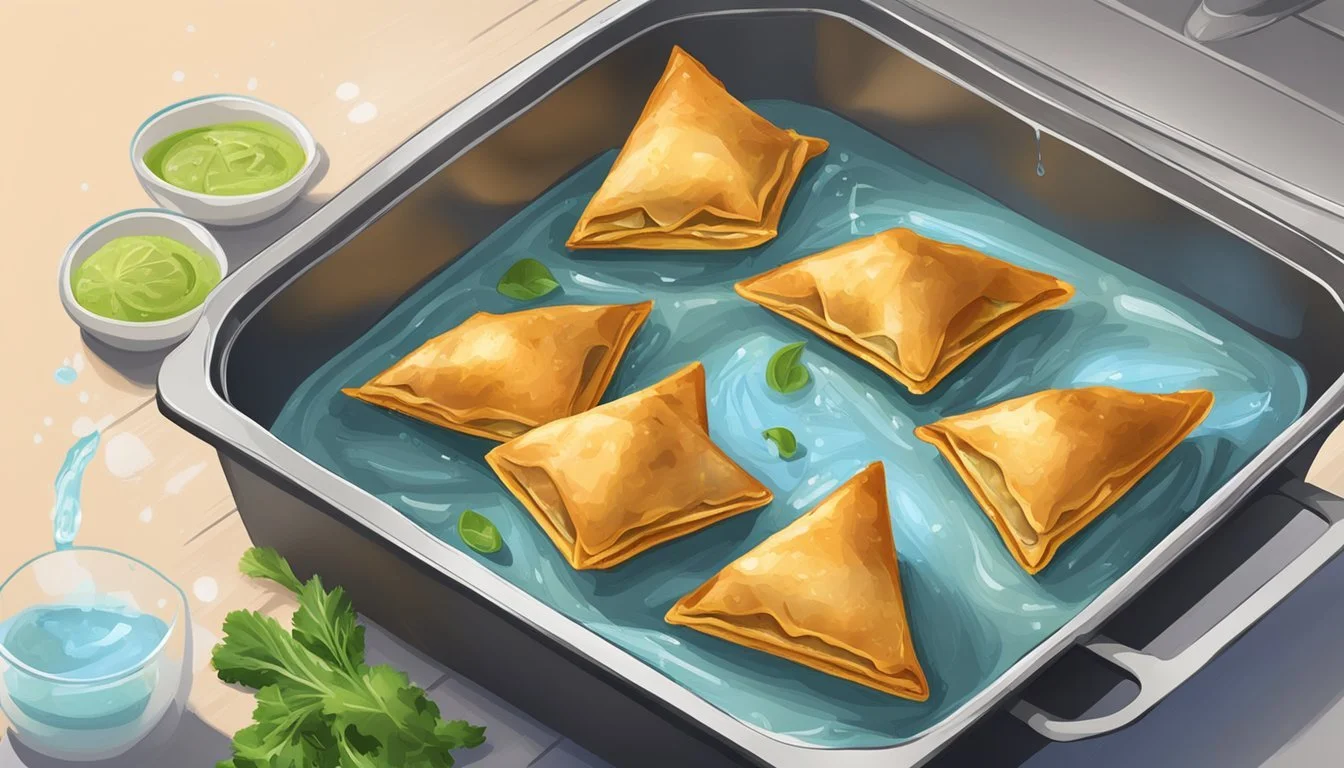Best Way to Reheat Vegetable Samosas
Ensuring Moist Filling Every Time
Reheating vegetable samosas properly is essential to ensure they retain their original flavor and texture. The key to a perfectly warmed samosa is to maintain the crispiness of the pastry while keeping the filling moist. Vegetable samosas, with their delicate blend of spices and vegetables, are particularly prone to drying out or becoming too soggy if not reheated carefully. This article details the most effective methods for reheating this popular snack.
Oven reheating is often recommended as it provides an even distribution of heat, which helps to preserve the desired texture of the pastry. By setting the oven to a moderate temperature and placing the samosas on a wire rack, the heat circulates around the food, crisping the outside while warming the filling gently. This method also allows any excess moisture to escape, preventing sogginess.
For those without the time to use an oven, microwaving can offer a quicker alternative. Although there's a risk of sogginess, using medium power and heating in short bursts can minimize this. It’s vital to flip the samosas during the process to ensure even heating. Some even choose to wrap the samosas in a paper towel to help absorb the steam and maintain crispiness. Each method has its nuances, and it's these details that make the difference between a samosa that's just reheated and one that's as close to freshly made as possible.
Understanding Samosas
Samosas are a popular savory snack, whose roots can be traced back to Central Asia and the Middle East. They have gained widespread popularity across the world, especially in South Asian cuisine, where they are a staple at many gatherings and special occasions.
Traditionally, samosas are triangular in shape and feature a crisp, deep-fried pastry shell. Their appeal lies in the combination of a flaky outer layer with a moist, flavorful filling. The fillings can vary greatly, but commonly include a mixture of spices, potatoes, onions, and peas. While these ingredients form the basis of the typical vegetarian samosa, variants with chicken, beef, or other meats are also prevalent.
Here is a brief overview of their traditional components:
Pastry: A thin flour-based dough, shaped into triangles.
Filling: Typically a mix of mashed potatoes, diced onions, peas, and spices like cumin, garam masala, coriander, and turmeric.
Meat Variations: Optionally includes minced chicken, beef or lamb.
The pastry is stuffed with the filling and then deep-fried to achieve a golden-brown finish with a satisfying crunch. When reheating, the challenge is to maintain the original texture and moisture of the filling without compromising the crispiness of the pastry. Samosas commonly serve as snacks, but can also accompany meals or be the star of a meal itself when paired with chutneys or curries.
Storing Samosas Properly
Proper storage of vegetable samosas is crucial to maintain their freshness and prevent mold. The method of storage varies depending on how long one wants to keep the samosas before they are consumed.
Short-Term Storage Techniques
For short-term storage, one should place vegetable samosas in an airtight container or wrap them tightly in aluminum foil or plastic wrap. This practice helps in retaining moisture and keeps the samosas fresh. They can then be refrigerated for 2-3 days. It is important to ensure that the samosas are completely cooled down to room temperature before refrigerating to prevent condensation, which can lead to sogginess and hasten mold growth. One can follow these steps:
Cool the samosas to room temperature.
Wrap individually in plastic wrap or place in an airtight container.
Refrigerate at a consistent temperature.
Long-Term Freezing Methods
To freeze samosas, the process involves individually wrapping the samosas to prevent freezer burn and then placing them in a heavy-duty freezer bag. It is important to remove as much air as possible from the freezer bag to protect the samosas' texture and flavor. Here’s how one can freeze vegetable samosas effectively:
Let the samosas cool completely to avoid moisture build-up.
Wrap each samosa tightly in cling film, aluminum foil, or freezer paper.
Place wrapped samosas in a freezer bag and squeeze out excess air before sealing.
Label the bag with the current date, and samosas can be stored safely for up to 3 months.
When one wants to enjoy the leftovers, they can reheat them straight from the freezer following the appropriate reheating methods, which ensures that the filling remains moist and the exterior crisp.
Reheating Fundamentals
Ensuring samosas retain their crispy exterior and moist filling requires careful selection of reheating methods. Below are different reheating techniques that can preserve the crunchy texture and delightful flavors of vegetable samosas.
Reheating Samosas in the Oven
To reheat samosas in the oven and maintain their crunchiness:
Preheat the oven to 350°F (175°C).
Arrange the samosas on a baking sheet lined with parchment paper.
Heat for 10-15 minutes until thoroughly warm and crispy.
Stovetop Reheating Techniques
For a crispy texture using the stove:
Heat a skillet or frying pan over medium flame.
Place the samosas in the pan without overcrowding.
Frequently turn the samosas until all sides are evenly crispy.
Microwave Reheating Tips
Microwaving samosas is the quickest method but can affect texture:
Place samosas on a microwave-safe plate.
Cover with a paper towel to absorb excess moisture.
Heat on medium power in short bursts to avoid sogginess.
Utilizing the Air Fryer
The air fryer is excellent for reviving the crispy texture:
Preheat the air fryer to 350°F (180°C).
Lightly spray the samosas with oil for extra crispness.
Air fry for 3-5 minutes, shaking the basket halfway through.
Deep Frying Leftovers
Deep-frying can restore the crunchy shell of fried samosas:
Heat oil in a deep-fryer or deep pan until hot.
Carefully lower the samosas into the oil for 2-3 minutes.
Drain on paper towels to remove any excess oil.
Alternative Reheating Methods
Other methods include:
Using a toaster oven guided by the same principles as a conventional oven.
Warming samosas on a barbecue grill for a unique smoky flavor.
Avoiding Common Reheating Mistakes
Do not: Reheat samosas too many times, as it advances texture degradation.
Avoid: Overcrowding the pan or baking sheet, which hinders even reheating.
Serving and Presentation
When presenting vegetable samosas, the main objectives are to highlight the samosa's natural crispness and complement the flavors with suitable accompaniments. The right dipping sauce can elevate the taste, while how the dish is served at gatherings can make a lasting impression.
Pairing with Dipping Sauces
Vegetable samosas pair wonderfully with an array of dipping sauces, each bringing out a different facet of the samosas' flavor profile. Two classic options are:
Tamarind Chutney: A sweet and tangy sauce that provides a perfect counterbalance to the savory filling.
Mint-Coriander Chutney: Offers a refreshing and herby kick that complements the warm spices within the samosa.
Serving these sauces in separate small bowls allows guests to choose their preferred flavor enhancer.
Serving at Gatherings
At gatherings, vegetable samosas serve not just as a dish but as a conversation starter. They should be arranged on a platter in a manner that's visually appealing and accessible. Here are some tips for presentation:
Display samosas on a warm platter to maintain their crispness.
Garnish with fresh herbs like cilantro to add color and a hint of freshness.
Use food labels to indicate different types of samosas if serving multiple varieties.
Serving them in a communal setting encourages a shared dining experience and allows guests to easily help themselves.
Maintaining Quality and Safety
When reheating vegetable samosas, one's primary goal is to preserve the crunchy exterior while ensuring the filling remains moist and safe to eat. It's essential to follow safe reheating practices to avoid foodborne illness.
Temperature: The samosas should be reheated to a safe internal temperature of 165°F. This kills any potential bacteria that might have developed during storage. Use a food thermometer to check the temperature.
Method: An oven or toaster oven is preferable for reheating samosas. They should be placed on a wire rack with a baking tray underneath to catch any drips. This setup allows hot air to circulate around the samosa, heating it evenly and maintaining its crunchiness.
Preheat the oven to 350°F
Reheat for 7-10 minutes, checking the warmth of the filling
Handling Moisture: To keep the filling moist while avoiding a soggy exterior:
Wrap samosas in paper towels to absorb excess moisture.
Heat at medium power if using a microwave in short bursts, flipping them halfway through to ensure even heating.
Avoiding Sogginess:
Do not microwave for prolonged periods; this could steam the pastry, making it soft.
Do not cover samosas with foil in the oven as this traps steam and softens the crust.
Safety Reminder:
Always wash hands before handling food.
Ensure that reheated items have not been left out at room temperature for more than 2 hours to minimize bacterial growth.
By adhering to these guidelines, one ensures that their reheated vegetable samosas are both safe to consume and enjoyable, retaining their intended texture and flavor.
FAQ: Samosas Reheating and Storage
In this section, readers will find essential information on reheating samosas to retain their moisture and ensuring the crispness of the exterior, as well as effective methods for storing leftover samosas and safety considerations when reheating multiple times.
Can You Reheat Fried Samosas?
Yes, one can reheat fried samosas. The preferred method to maintain taste and texture is using an oven. Heating at 350°F (175°C) for 7-10 minutes should suffice for small to medium-sized samosas. If they are larger, a quick 10-second burst in the microwave before transferring to the oven ensures a warm filling.
How to Ensure Crispy Samosas After Reheating?
To ensure crispy samosas after reheating, utilize an oven or toaster oven. Place samosas on a wire rack over a baking sheet and reheat at a moderate temperature to allow even heating without burning. It's crucial not to cover the samosas, as condensation can make them soggy.
Best Ways to Store Leftover Samosas?
Leftover samosas should be stored properly to maintain their quality:
Cool Down: Let the samosas cool to room temperature before storing.
Seal Tightly: Wrap individual samosas in foil or store them in an airtight container.
Refrigerate or Freeze: Keep in the fridge for 2-3 days or freeze for up to 1 month for best results.
Is It Safe to Reheat Samosas Multiple Times?
It is safe to reheat samosas multiple times as long as they are heated to an internal temperature of 165°F (74°C) each time. However, it is not recommended to reheat samosas multiple times as this can degrade their quality, potentially drying out the filling and making the pastry tough.





